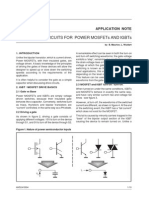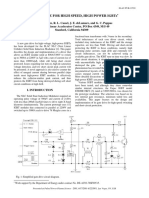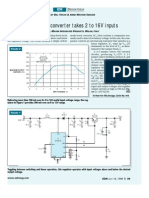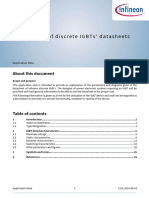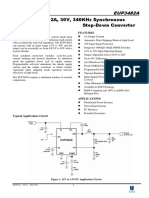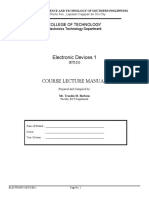0 ratings0% found this document useful (0 votes)
69 viewsInfineon Bodos - Parasitic - Turn On Article v01 - 00 EN PDF
Infineon Bodos - Parasitic - Turn On Article v01 - 00 EN PDF
Uploaded by
rajat tiwariCopyright:
© All Rights Reserved
Available Formats
Download as PDF, TXT or read online from Scribd
Infineon Bodos - Parasitic - Turn On Article v01 - 00 EN PDF
Infineon Bodos - Parasitic - Turn On Article v01 - 00 EN PDF
Uploaded by
rajat tiwari0 ratings0% found this document useful (0 votes)
69 views4 pagesOriginal Title
Infineon-Bodos_Parasitic_turn-on-Article-v01_00-EN.pdf
Copyright
© © All Rights Reserved
Available Formats
PDF, TXT or read online from Scribd
Share this document
Did you find this document useful?
Is this content inappropriate?
Copyright:
© All Rights Reserved
Available Formats
Download as PDF, TXT or read online from Scribd
Download as pdf or txt
0 ratings0% found this document useful (0 votes)
69 views4 pagesInfineon Bodos - Parasitic - Turn On Article v01 - 00 EN PDF
Infineon Bodos - Parasitic - Turn On Article v01 - 00 EN PDF
Uploaded by
rajat tiwariCopyright:
© All Rights Reserved
Available Formats
Download as PDF, TXT or read online from Scribd
Download as pdf or txt
You are on page 1of 4
The parasitic turn-on behavior of discrete CoolSiC™ MOSFETs
Parasitic turn-on caused by the Miller capacitance is often considered a weak spot of today’s silicon
carbide MOSFETs. In order to avoid that effect, gate-drive designs for hard-switching converters are
typically implemented with negative turn-off gate voltages. But is that really needed with CoolSiC™
MOSFETs?
By Klaus Sobe, Infineon Technologies Austria AG
Introduction stronger pull-up of the gate voltage, but also lower
A key element of all gate-drive designs is the the threshold level. On the hardware side, the
selection of the gate-voltage levels. With the major factors of influence are the undesirable
CoolSiC™ MOSFET technology, Infineon allows parasitic board capacitance parallel to CGD, an
designers to choose a turn-on gate voltage external capacitor parallel to CGS, the turn-off gate
between 18 V and 15 V, and thus configure the voltage as well as the turn-off gate resistor.
switch for highest current-carrying capability or
short-circuit ruggedness, respectively. The turn-off
gate voltage level, on the other hand, only needs
to ensure that the device remains safely turned off.
Infineon encourages designers to operate its
discrete MOSFETs at 0 V and benefit from a
simplification of the gate-drive circuit.
In order to underline that encouragement, this
article introduces an easily reproducible approach
to characterize the susceptibility of silicon carbide
MOSFETs, and presents tests results obtained
with discrete CoolSiC™ MOSFETs. Figure 1: Impact of the Miller capacitance CGD during
the turn-off of the body diode
Parasitic turn-on effect Characterization setup and approach
An unwanted turn-on of a semiconductor switch Designers often study the gate-charge curve of a
can be caused by inductive as well as capacitive specific semiconductor switch in order to get an
feedback to the gate. In conjunction with silicon impression of its susceptibility to parasitic turn-on.
carbide MOSFETs, however, it is typically the While this approach is rather straightforward – a
capacitive feedback via the Miller capacitance that brief look into the data sheet is sufficient – it does
is considered. A scenario explaining this effect is not really enable conclusions to be drawn for the
shown in Figure 1. The body diode of the low-side application. The main shortcoming is that the gate-
switch S2 conducts the load current IL until the charge characteristic is rather static in nature,
high-side switch S1 turns on. After the load current while the parasitic turn-on is clearly a dynamic
has commutated to S1, the drain-source voltage of effect. Hence, dedicated characterization tests are
S2 starts to increase. During this phase, the rising performed to assess the parasitic turn-on behavior
drain potential pulls up the gate voltage of S2 via of 1200 V/45 mΩ CoolSiC™ MOSFETs in TO-247
the Miller capacitance CGD. The turn-off gate 3-pin and 4-pin packages under application
resistor tries to counteract and pull the voltage conditions. All tests are conducted with a turn-off
down. If this resistor value is not low enough to gate voltage of 0 V.
pull the voltage down, the voltage might exceed
the threshold level, leading to a shoot-through and
an increase of switching losses.
Naturally, the risk and severity of shoot-through
events depend on the particular operation
conditions and the measurement hardware. The
most critical operating points are at high bus
voltages, steep voltage rises and high junction
temperatures. These conditions not only lead to a
Figure 2: Hardware setup for the characterization: the
high-side switch S1 acts as “dv/dt generator”, the low-
side switch S2 is the device under test. The aim of the
test is to find the maximum turn-off gate resistance for Figure 3: Example waveforms obtained with a
S2 that still avoids parasitic turn-on. 1200 V/45 mΩ CoolSiC™ MOSFET operated at
100°C and with different values for RGoff. Compared
A half-bridge evaluation board is configured as to the reference waveform (black; 0 Ω), Q*rr of the
depicted in the schematic drawing of Figure 2. It is other waveforms are increased by 10% (orange;
essentially a commutation cell where the low-side 12 Ω) and 40% (red; 22 Ω). The symbol Q*rr denotes a
switch is the device under test and the high-side sum of three charges: (1) the reverse recovery
switch acts as dv/dt generator. When the high-side charge of the body diode, (2) the capacitive charge of
device turns on, the rising drain-source voltage on the semiconductors, the layout and the passives, and
the low-side device leads to a gate voltage (3) the contribution coming from parasitic turn-on.
increase that the turn-off gate resistor tries to limit.
Naturally, the lower the dvDS/dt, and the lower the
turn-off gate resistance, the lower is the chance of Characterization results
a parasitic turn-on. The goal of the experiment is Testing at zero load current means that the body
to identify the critical turn-off gate resistance diode of the device under tests is not forward
values for a given test case. This so-called critical biased prior to the switching transient. No diode
gate resistance is the value that causes a Q*rr recovery occurs; the transient is merely a charging
increase of 10% compared to the reference and discharging of capacitances. In this condition,
waveform obtained with 0 Ω. A threshold level of voltages induced in parasitic inductances do not
10% is large enough to get reliable measurement play a significant role. Consequently, also the
data, but small enough to be considered negligible performance of the TO-247 and the TO-247-4-pin
in most applications, cf. Figure 3. package is the same.
Tests are carried out at different temperatures, The measurement results obtained at 800 V and
different load currents and different voltage slopes. 0 A are summarized in Figure 4. It is clearly visible
The latter are adjusted using the RGon of the high- that in order to prevent parasitic turn-on, the RGoff
side switch S1. needs to be lower, the higher the dvDS/dt and the
higher the temperature. It is worth mentioning that
a turn-off gate voltage of 0 V is sufficient to prevent
parasitic turn-on even at 50 V/ns and 175°C. In
case the RGoff cannot be selected at a level that is
low enough, drivers with an active Miller-clamp
functionality such as the 1EDC30I12MH provide a
way out.
differentiate. Both effects slow down or smooth the
voltage transient, and cause an increase of the
switching energies, not only on the diode but also
on the switch. In applications that require highest
switching speeds, parasitic turn-on limits the
performance similar to an improper freewheeling
diode.
Figure 5 shows the minimum achievable turn-on
switching losses of various silicon carbide
MOSFET technologies operated with 18/0 V on the
gate. While not all devices are able to maintain
their high-speed switching nature at such a driving
condition, the results confirm the high immunity of
CoolSiC™ MOSFETs against parasitic turn-on.
Figure 4: Critical gate resistor values as a function of
dvDS/dt for the 1200 V/45 mΩ CoolSiC™ MOSFET
under test. The measurement points were obtained at
800 V and 0 A using a turn-off gate voltage of 0 V. The
dashed lines indicate calculated trend lines.
At higher load current levels, a hard commutation
from the body diode of S2 to the MOS channel of
S1 occurs. Due to the presence of diode reverse Figure 5: Minimum achievable turn-on switching
recovery and induced voltages, the situation losses of various 1200 V silicon carbide MOSFET
technologies at 800 V, 15 A and 150°C. The devices
becomes slightly more complicated. Simply
under test have a nominal on-state resistance of 60-
speaking, three effects come into play:
80 mΩ and are operated with 18/0 V on the gate.
1) The body diode recovery slows down the
average dvDS/dt and relaxes the situation Summary and conclusion
with parasitic turn-on. This article describes a simple approach for
2) Oscillations between the commutation loop characterizing the susceptibility of a power
inductance and the device output semiconductor switch to parasitic turn-on via the
capacitance increase the dvDS/dt locally Miller capacitance. Test results obtained with
and make the situation more critical. discrete CoolSiC™ MOSFETs operated at a bus
3) Assuming a standard TO-247 package, the voltage of 800 V and a switching speed of 50 V/ns
negative feedback via the common source demonstrate that even in high-speed, two-level
terminal of S2 leads to a reduction of the converters, a turn-off gate voltage of 0 V is feasible.
gate voltage, and thus to an increased When looking at three-level circuits where the
ruggedness against parasitic turn-on. switched voltage is just half the bus voltage, the
Apparently, the weighting of the effects described situation eases entirely. In such cases, CoolSiC™
above depends on the actual hardware setup. With MOSFETs are virtually free of capacitive turn-on,
the evaluation board that was used for all tests regardless of the gate resistance value.
presented in this article, the most critical condition Assuming a carefully designed PCB layout with
is 175°C and 0 A. Thus, the area that is free of minimized gate-drain capacitance, Infineon
parasitic turn-on highlighted in Figure 4 holds for encourages power electronic engineers to operate
40 A measurements, too – regardless of whether discrete CoolSiC™ MOSFETs with a turn-off gate
the TO-247 or TO-247-4-pin is considered. voltage of 0 V. This leads to a simplification of the
Implications on high-speed switching gate-drive design without penalizing the
applications performance.
As indicated in Figure 3, the shoot-through current
caused by the capacitive turn-on and the reverse-
recovery current of the body diode are difficult to
References [4] S. Jahdi et al, “Investigation of parasitic turn-
[1] K. Sobe et al, “Characterization of the parasitic ON in silicon IGBT and Silicon Carbide
turn-on behavior of discrete CoolSiC™ MOSFET devices: A technology evaluation”,
MOSFETs”, PCIM Europe 2019, Nuremberg, ECCE-Europe 2015, Geneva, Switzerland,
Germany, May 2018 September 2015
[5] Infineon AN-2017-44: “1200V Highspeed3
[2] T. Basler et al, “Practical Aspects and Body IGBT in TO-247PLUS Evaluation Board”,
Diode Robustness of a 1200 V SiC Trench Application Note (rev 1), November 2017
MOSFET”, PCIM Europe 2018, Nuremberg,
Germany, June 2018
[3] Infineon AN-2006-01: “Driving IGBTs with
unipolar gate voltage”, Application Note,
December 2005
You might also like
- 24V Battery Charger With SCRDocument8 pages24V Battery Charger With SCRluisNo ratings yet
- Study of Over Current RelayDocument6 pagesStudy of Over Current RelayDarshana ChathurangaNo ratings yet
- An 6076Document13 pagesAn 6076Khúc Hành QuânNo ratings yet
- An 6076Document13 pagesAn 6076Kannabhiran Arumugam100% (1)
- Analog Latch One Shot CircuitsDocument3 pagesAnalog Latch One Shot CircuitsAnders JohanssonNo ratings yet
- CD00003900 PDFDocument10 pagesCD00003900 PDFCactuSound CactusRecordsNo ratings yet
- Drive Circuits For Power Mosfets and IgbtsDocument11 pagesDrive Circuits For Power Mosfets and IgbtsZamanundaIEEENo ratings yet
- AN665Document6 pagesAN665VIJAYPUTRANo ratings yet
- Gate Drive For High Speed, High Power IgbtsDocument4 pagesGate Drive For High Speed, High Power IgbtsAhmadNo ratings yet
- Isolated Gate Driver For SiC MOSFETs With Constant Negative Off VoltageDocument4 pagesIsolated Gate Driver For SiC MOSFETs With Constant Negative Off VoltageHainan DingNo ratings yet
- An-990 Application Characterization of IGBT'sDocument31 pagesAn-990 Application Characterization of IGBT'sVasco RodriguesNo ratings yet
- IGBT Characteristic CurveDocument17 pagesIGBT Characteristic CurveSanaKayaniNo ratings yet
- Chapter 7 - Driving Thytistors and TransistorsDocument11 pagesChapter 7 - Driving Thytistors and Transistorsmitros100% (2)
- An4671 How To Fine Tune Your Sic Mosfet Gate Driver To Minimize Losses StmicroelectronicsDocument17 pagesAn4671 How To Fine Tune Your Sic Mosfet Gate Driver To Minimize Losses Stmicroelectronicsbofid61905No ratings yet
- Transistor P2N06CLDocument7 pagesTransistor P2N06CLPauloPecegueiroNo ratings yet
- Using Standard Control Ics To Generate Negative Gate Bias For Mosfets and IgbtsDocument4 pagesUsing Standard Control Ics To Generate Negative Gate Bias For Mosfets and IgbtsVincent KorieNo ratings yet
- IGBT BasicsDocument20 pagesIGBT Basicsscrewyou2222No ratings yet
- lab7Document5 pageslab7madnir99No ratings yet
- Index: Web Space - Website Hosting - Business Hosting - Free Website Submission - Shopping Cart - PHP HostingDocument12 pagesIndex: Web Space - Website Hosting - Business Hosting - Free Website Submission - Shopping Cart - PHP Hostingcelo81No ratings yet
- IRF7807VD2: Fetky™ Mosfet / Schottky DiodeDocument9 pagesIRF7807VD2: Fetky™ Mosfet / Schottky DiodeMartin TorresNo ratings yet
- Is Now Part ofDocument6 pagesIs Now Part ofJairo FernandezNo ratings yet
- I GB T ApplicationDocument17 pagesI GB T ApplicationSachin ThomasNo ratings yet
- PID6591429Document4 pagesPID6591429RobertoCarlosGiacchettaNo ratings yet
- Application Note: Extremely Compact, Isolated Gate Driver Power Supply For Sic-Mosfet (6 - 10 W)Document5 pagesApplication Note: Extremely Compact, Isolated Gate Driver Power Supply For Sic-Mosfet (6 - 10 W)Wesley de PaulaNo ratings yet
- Is Now Part ofDocument15 pagesIs Now Part ofSaikumarNo ratings yet
- (Power Electronics) Semester: IIDocument52 pages(Power Electronics) Semester: IIp19209425No ratings yet
- Research On High Power Density Sic Mosfet Driver Circuit: Shaokun Zhang, Guolin He, Dan Zheng, Tao Fan, Xuhui WenDocument6 pagesResearch On High Power Density Sic Mosfet Driver Circuit: Shaokun Zhang, Guolin He, Dan Zheng, Tao Fan, Xuhui WenghhNo ratings yet
- Spice Model Laser Diode 15diDocument8 pagesSpice Model Laser Diode 15diParker333100% (1)
- SCR Triggering MethodsDocument17 pagesSCR Triggering MethodssriNo ratings yet
- Solditron SP245-01 Cpak Datasheet-1Document4 pagesSolditron SP245-01 Cpak Datasheet-1Servis ChipoNo ratings yet
- Vincotech TP 2018 05 The Challenges of Using SiC MOSFET-based Power Modules For Solar Inverters Tauer MatthiasDocument5 pagesVincotech TP 2018 05 The Challenges of Using SiC MOSFET-based Power Modules For Solar Inverters Tauer MatthiasCan IlicaNo ratings yet
- AN764 Debounce SwitchDocument15 pagesAN764 Debounce Switchd.c.delatorre2200No ratings yet
- Parasitic Turn On of Sic Mosfets Turning A Bug Into FeatureDocument9 pagesParasitic Turn On of Sic Mosfets Turning A Bug Into Featureelmarvin22No ratings yet
- Automatic 12V Lead Acid Battery ChargerDocument10 pagesAutomatic 12V Lead Acid Battery ChargerRajib Chatterjee100% (1)
- Ecler Pam2000 Pam2600 Power Amplifier Service ManualDocument107 pagesEcler Pam2000 Pam2600 Power Amplifier Service Manuallluissb92% (12)
- Guide SSHV2Document4 pagesGuide SSHV2vinhson65-1No ratings yet
- Fdd16an08a0 D-2312134Document15 pagesFdd16an08a0 D-2312134DR4 726No ratings yet
- Electric Power Voltage: Sag SolutionsDocument14 pagesElectric Power Voltage: Sag SolutionsRamiz RazaNo ratings yet
- Infineon-AN2006 01 Driving IGBTs With Unipolar Gate Voltage-An-V1.0-EnDocument8 pagesInfineon-AN2006 01 Driving IGBTs With Unipolar Gate Voltage-An-V1.0-EnDavid ZammitNo ratings yet
- Triac ControlDocument6 pagesTriac ControlSyaiful BakhriNo ratings yet
- And8142 DDocument10 pagesAnd8142 DJonatan LunaNo ratings yet
- Lab 1Document4 pagesLab 1Charles BentonNo ratings yet
- P E Lab FinalDocument63 pagesP E Lab FinalARVIND100% (1)
- Answer Key Power ElectrnicsDocument17 pagesAnswer Key Power ElectrnicsVanchinathan KNo ratings yet
- Mosfet: Huda Mohammed Stage 3Document11 pagesMosfet: Huda Mohammed Stage 3الزهور لخدمات الانترنيتNo ratings yet
- Viva QuestionsDocument12 pagesViva QuestionsJayesh Tanwani60% (5)
- Thyristor Turn On Turn Off Methods IIDocument14 pagesThyristor Turn On Turn Off Methods IIkshitijsilawatNo ratings yet
- Mtw8n60e DDocument9 pagesMtw8n60e DAtiqurrehman UmairNo ratings yet
- Cres PDFDocument5 pagesCres PDFRoussos GeorgiadisNo ratings yet
- Sayas Wara GadaDocument18 pagesSayas Wara GadaisseywarragadaaNo ratings yet
- PE InsemDocument4 pagesPE Insemdnyaneshwarpiwal07No ratings yet
- Reference Guide To Useful Electronic Circuits And Circuit Design Techniques - Part 2From EverandReference Guide To Useful Electronic Circuits And Circuit Design Techniques - Part 2No ratings yet
- Reference Guide To Useful Electronic Circuits And Circuit Design Techniques - Part 1From EverandReference Guide To Useful Electronic Circuits And Circuit Design Techniques - Part 1Rating: 2.5 out of 5 stars2.5/5 (3)
- Analog Dialogue Volume 46, Number 1: Analog Dialogue, #5From EverandAnalog Dialogue Volume 46, Number 1: Analog Dialogue, #5Rating: 5 out of 5 stars5/5 (1)
- STEM: Science, Technology, Engineering and Maths Principles Teachers Pack V10From EverandSTEM: Science, Technology, Engineering and Maths Principles Teachers Pack V10No ratings yet
- Influence of System Parameters Using Fuse Protection of Regenerative DC DrivesFrom EverandInfluence of System Parameters Using Fuse Protection of Regenerative DC DrivesNo ratings yet
- Infineon FP100R12N3T7 DataSheet v00 - 21 ENDocument21 pagesInfineon FP100R12N3T7 DataSheet v00 - 21 ENrajat tiwariNo ratings yet
- Applications of Line and Load Reactors With Variable Frequency Drives PDFDocument4 pagesApplications of Line and Load Reactors With Variable Frequency Drives PDFrajat tiwariNo ratings yet
- Women Voters in Indian Democracy: A Silent Revolution: Mudit Kapoor and Shamika Ravi June 27, 2013Document28 pagesWomen Voters in Indian Democracy: A Silent Revolution: Mudit Kapoor and Shamika Ravi June 27, 2013rajat tiwariNo ratings yet
- Bootstrap Circuitry Selection For Half-Bridge ConfigurationsDocument10 pagesBootstrap Circuitry Selection For Half-Bridge ConfigurationsJerson Andres QuinteroNo ratings yet
- Infineon-Discrete IGBT Datasheet Explanation-AN-v01 00-EN PDFDocument29 pagesInfineon-Discrete IGBT Datasheet Explanation-AN-v01 00-EN PDFrajat tiwariNo ratings yet
- Circuit Note: H-Bridge Driver Circuit Using Isolated Half-Bridge DriversDocument6 pagesCircuit Note: H-Bridge Driver Circuit Using Isolated Half-Bridge Driversrajat tiwariNo ratings yet
- ISM MTech InformationBulletinDocument21 pagesISM MTech InformationBulletinrajat tiwariNo ratings yet
- 1 JhhuDocument2 pages1 Jhhurajat tiwariNo ratings yet
- Details of Advertisement and General TermsDocument5 pagesDetails of Advertisement and General Termsrajat tiwariNo ratings yet
- PG Bulletin 21juneDocument147 pagesPG Bulletin 21junerajat tiwariNo ratings yet
- MT Sy PeedDocument7 pagesMT Sy Peedrajat tiwariNo ratings yet
- Error Codes Bizhub Series XX7Document35 pagesError Codes Bizhub Series XX7ctecisbNo ratings yet
- Mod 4 ToyolDocument12 pagesMod 4 Toyolwmfadzli7265No ratings yet
- RXSF Flag Relay - UnlockedDocument20 pagesRXSF Flag Relay - UnlockedDaniel ChristianNo ratings yet
- Error Code Manual For ECORAY Generator XR7Document16 pagesError Code Manual For ECORAY Generator XR7Tekniah Global100% (2)
- AH276Document10 pagesAH276Oki NoriNo ratings yet
- Motor Starter AnalysisDocument122 pagesMotor Starter AnalysisKeerrthanaa KumaraveluNo ratings yet
- EUP3482ADocument1 pageEUP3482AJorge AdrianNo ratings yet
- PCE Catalogue 2011Document14 pagesPCE Catalogue 2011atnkpr_vn9368No ratings yet
- Speed Control of BLDC Motor Using Hybrid Controller: Strart UpDocument49 pagesSpeed Control of BLDC Motor Using Hybrid Controller: Strart UpAswani MucharlaNo ratings yet
- TD180 - Iss A - Reversing The Direction of Movement of An EL Positioner - Visual GuideDocument3 pagesTD180 - Iss A - Reversing The Direction of Movement of An EL Positioner - Visual Guidekali bangonNo ratings yet
- As 61818-2005 Application Guide For Low-Voltage FusesDocument8 pagesAs 61818-2005 Application Guide For Low-Voltage FusesSAI Global - APACNo ratings yet
- DatasheetDocument113 pagesDatasheetAlanRamiroNo ratings yet
- 08 - Proximity Switch Inductive Sensor IGM204Document2 pages08 - Proximity Switch Inductive Sensor IGM204Aki NguyenNo ratings yet
- Pfisterer MV CONNEX Inner Cone Plug Cable Terminations Size 0 To 3SDocument71 pagesPfisterer MV CONNEX Inner Cone Plug Cable Terminations Size 0 To 3Sreivin27No ratings yet
- Be Electronics and Telecommunication Engineering Semester 6 2024 March Power Devices and Circuits Pd c Pattern 2019Document2 pagesBe Electronics and Telecommunication Engineering Semester 6 2024 March Power Devices and Circuits Pd c Pattern 2019rahulrudrarupamNo ratings yet
- Module 5 - Elec Dev 1Document18 pagesModule 5 - Elec Dev 1Maria Hazelle AbdalaNo ratings yet
- Rev3 - PYB625D, Balimbing, RBS6601 Enclosure RRUS1800 DUG20 6+6+6Document1 pageRev3 - PYB625D, Balimbing, RBS6601 Enclosure RRUS1800 DUG20 6+6+6Okas PaskalNo ratings yet
- Pengumuman DPT Vendor Komponen TrafoDocument3 pagesPengumuman DPT Vendor Komponen Trafodenny yusufNo ratings yet
- Das2 Revisions 1Document1 pageDas2 Revisions 1marlon habonNo ratings yet
- S98 Lecture13Document12 pagesS98 Lecture13manohar487No ratings yet
- Clearance Measurement For Tilting Pad BearingsDocument16 pagesClearance Measurement For Tilting Pad BearingszulmodangguNo ratings yet
- MISK Method Statement Status LogDocument2 pagesMISK Method Statement Status LogehteshamNo ratings yet
- 1) Move C1013 Out of Shield (Layout) 2) Swap D132 and D143 (Layout) 3) Add R25 For R3000 (Schemaitc and Layout) 4) Change C51 To Through HoleDocument17 pages1) Move C1013 Out of Shield (Layout) 2) Swap D132 and D143 (Layout) 3) Add R25 For R3000 (Schemaitc and Layout) 4) Change C51 To Through HoleOlegNo ratings yet
- Nano GuardDocument2 pagesNano GuardJesus VerduzcoNo ratings yet
- Theft Deterrent Horn CircuitDocument2 pagesTheft Deterrent Horn CircuitsalusfrankNo ratings yet
- 91604diDocument6 pages91604dimasoudNo ratings yet
- Phase Failure Relay PFR GC1100Document1 pagePhase Failure Relay PFR GC1100Delta PratamaNo ratings yet
- Li-MnO2 Batteries (Varta)Document4 pagesLi-MnO2 Batteries (Varta)MedSparkNo ratings yet
- AWP-03 Breakdown AnalysisDocument2 pagesAWP-03 Breakdown Analysisvitthal01No ratings yet






